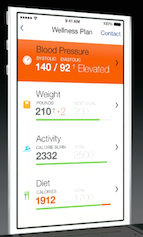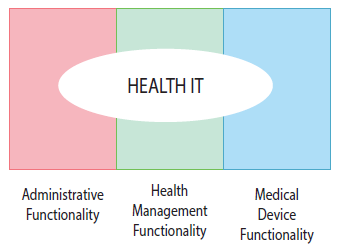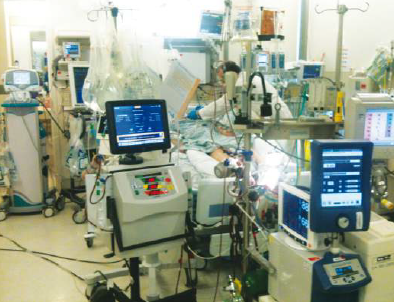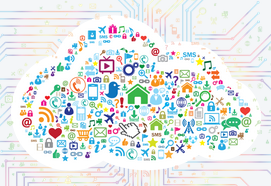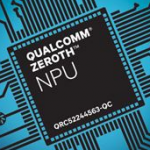 The Internet of Things (IoT) is being propelled by the dramatic reduction in size, power consumption, and cost of networking and computing capability. Many of the devices listed in the Wolfram Connected Devices Project are health related. "Things" like weight scales and thermometers can make measurements from many objects, but when that object is a human body, they effectively become medical devices. The sensors that come standard on smart phones also fit into this category. All of these network-connected devices that record data from humans make up the Internet of Medical Devices (IoMD).
The Internet of Things (IoT) is being propelled by the dramatic reduction in size, power consumption, and cost of networking and computing capability. Many of the devices listed in the Wolfram Connected Devices Project are health related. "Things" like weight scales and thermometers can make measurements from many objects, but when that object is a human body, they effectively become medical devices. The sensors that come standard on smart phones also fit into this category. All of these network-connected devices that record data from humans make up the Internet of Medical Devices (IoMD).
In most ways the invasion of technology in Healthcare is no different than how mobile digital capability is changing that way we all live. For Healthcare though, the potential benefits of applying these technologies to solve both the cost problem and to improve patient safety and outcomes are tremendous.
The number of technologies and innovations (health tracking apps and devices, home monitoring, medication management, etc.) that are contributing to these goals are too numerous to count. From a medical device perspective there are four primary areas of concern that need to be addressed as the IoMD grows.
1. Interoperability
As I've written about many times (e.g. Interoperability: Arrested Progress), health data interoperability is a key factor in realizing both cost reductions and improved patient outcomes. Unfortunately, medical data is notoriously complex, which makes effective communication between systems very difficult.
Another significant barrier to interoperability are EHR interfaces. The issue is that each EMR vendor has a propitiatory interface for consuming device data and associating it with a patient record. Without a direct device interface, data has to be manually transcribed into the record which is expensive and error prone.
This is a particular problem in the ambulatory EMR market because there are literally hundreds of vendors. Even if they all used a standard like HL7 there is still interfacing work that has to be done for each one. It is prohibitively expensive for any device company to develop and maintain that many interfaces.
2. Patient Safety
Because proper handling and presentation of medical data pose a safety risk the FDA has recently stepped in:
Most medical software applications, like the ones you might download to your Apple or Android phone, will not be affected by these regulations.
3. Privacy
Even though PHI (Protected Health Information) is protected by Health Information Privacy (HIPAA) laws most people consider their health a very private issue. Privacy concerns are a significant psychological barrier that must be overcome before sharing of medical data becomes commonplace.
4. Security
Reports like the one described in The Internet Of Things Has Been Hacked, And It's Turning Nasty are not encouraging:
Pinging one device brought up a login screen that said: Welcome To Your Fridge. She typed in a default password—something like “admin” or "adminadmin," Knight said—and suddenly had access to the heart of someone's kitchen.
The IoMD is not immune from this. Hacking Insulin Pumps And Other Medical Devices From Black Hat was big news last year. <TongueInCheek>If we're not careful search engines like Shodan will soon be discovering pace makers near real hearts!</TongueInCheek>
Final Notes
- The interoperability issue is not a technical problem per se. It reminds me of the challenges associated with an object-relational impedance mismatch ("Deceptive Similarities, Subtle Differences"). Also, not only are our models of human-derived data imperfect, but two models created for the same thing will most likely be different.
- The IoMD must convince the public that their data is safe and secure.
- If mobile medical applications and connected health monitoring devices are going to contribute to a more effective Healthcare delivery system they must be able to reliably and securely communicate the data they collect to an appropriate care provider.
UPDATE (1/25/14): Also see: Digital Health In 2014: The Imperative Of Connectivity
UPDATE (2/19/14): I like “Medical Internet of Things” (mIOT) too: Keeping medical device designs relevant in a big data world migrating to outcomes-driven payment models.
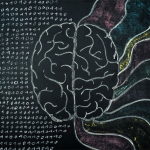 IBM Unveils a ‘Brain-Like’ Chip With 4,000 Processor Cores. The TrueNorth chip mimics 1 million neurons and 256 million synapses that IBM calls “spiking neurons.”
IBM Unveils a ‘Brain-Like’ Chip With 4,000 Processor Cores. The TrueNorth chip mimics 1 million neurons and 256 million synapses that IBM calls “spiking neurons.”
